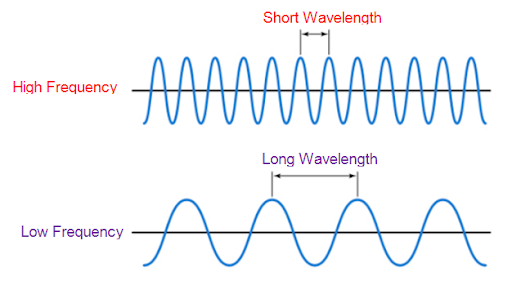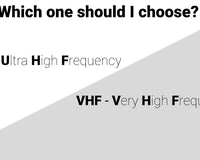One of the most frequently asked questions that we receive from customers, especially customers who don’t currently have two-way radios, is “Which Is Better – UHF or VHF?”.
This is a very good question to ask as picking the wrong frequency band can lead to problems later. UHF (Ultra High Frequency) and VHF (Very High Frequency) two-way radios each have their advantages and disadvantages. We will discuss these advantages and disadvantages in the sections that follow so that you can choose the correct frequency band for your application.
But first, we need to talk briefly about the characteristics of both VHF and UHF bands so you will hopefully have a better understanding of which to choose for your particular application.
What are the differences between UHF and VHF?
In general, VHF radios operate in the 138-174 MHz frequency band and UHF radios operate in the 400-512 MHz frequency band making UHF roughly three times higher in frequency than VHF. One important characteristic of radio waves is the wavelength which is the distance between peaks on a wave:

Wavelength is inversely proportional to the frequency. What this means is, lower frequencies have longer wavelengths while higher frequencies have shorter wavelengths. Why is this important? Lower frequencies with their longer wavelengths tend to travel longer distances in open spaces outside, curving with the distant horizon while higher frequencies, with their shorter wavelengths, tend to travel in straight lines and do not bend with the curvature of the earth.
Here's real world example that you have probably experienced:
If you have listened to AM radio at night, you typically can hear radio stations many hundreds of miles away from you. This is due to AM radio stations broadcasting in the 0.525 to 1.705 MHz band resulting in wavelengths that are roughly 100 times longer than VHF and 300 times longer than UHF. The wavelengths are so long that they sometimes can’t penetrate the earth’s atmosphere so they bounce off and head back down to earth which allows them to travel great distances. This is sometimes referred to as "skip".
Likewise, FM radio broadcasts range from 88 to 108 MHz, almost reaching the VHF band. Get 30 to 40 miles from a FM station and you start to hear static. This is because their wavelengths are much shorter than AM, can penetrate the earth’s atmosphere (so they don’t bounce off of it like AM does) and they travel more in a straight line than AM waves so they are more susceptible to the curvature of the earth.
Remember, the lower the frequency, the longer the wavelength, the greater the talk distance but with less penetrating ability. The higher the frequency, the shorter the wavelength, the talk distance is reduced but with more penetrating ability.
OK, that’s the end of the science lesson.
How does all of this relate to picking a radio?
Certain applications are better suited to lower frequency, longer wavelength VHF radios while other applications are better served using higher frequency, shorter wavelength UHF radios.
UHF vs VHF – Advantages and Disadvantages
Each band has advantages and disadvantages depending on the application.
VHF, since it tends to bend with the curvature of the earth more than UHF, is ideal for outdoor applications where distance is the primary user need. However, a big disadvantage of VHF is that it does not work well indoors as it will not penetrate walls or reinforced concrete as well as UHF.
UHF, with its higher frequencies and shorter wavelengths, will penetrate structures better than VHF so it should be used any time a user needs to communicate indoors, especially when trying to talk thru reinforced concrete structures. UHF is also the better choice in urban areas with a lot of houses and commercial buildings that the radio signal will be passing thru. However, the disadvantage of UHF is that its range will be less outside when compared to VHF.
VHF vs UHF – Real World Applications
Most public safety agencies in rural counties (Sheriff, Fire, EMS, etc) use VHF radios, especially in areas with low population density and hills and valleys. Surveyors, hikers, hunters, golf course personnel, farmers and anyone else primarily using their radios outside in rural areas would all be good candidates for VHF radios.
Large construction projects, schools, large entertainment venues, hotels, retail stores, manufacturing facilities, hospitals, high rise buildings, casinos and anyone else primarily using their radios inside or inside/outside in urban areas would all be good candidates for UHF radios.
UHF radios are much more popular overall than VHF radios in most applications where distance is not the primary need as they tend to be more versatile than VHF radios.
Can UHF and VHF Radios Communicate With Each Other?
Another question that we often get is “Can UHF and VHF radios communicate with each other?”. The answer to this question is NO for most radios. There are some high-end public safety grade radios than can talk across both bands but they cost many thousands of dollars and are not a practical option for most radio users. Beware of cheap Chinese radios that claim to talk over both bands. Real world use shows these radios to be unreliable and often their transmissions are so out of FCC specifications that they can interfere with the other radios in your fleet, or worse, with the radios being used by other organizations around you. The vast majority of these Chinese radios do not have FCC approval for use and, therefore, are not legal for operation in the USA.
Still have questions about which radio frequency band is right for you?
Please call one of our Motorola Master Certified radio consultants at (888) 733-7681 and they will be happy to get you into the correct radio for your needs.
Or fill out the contact us form for support.






